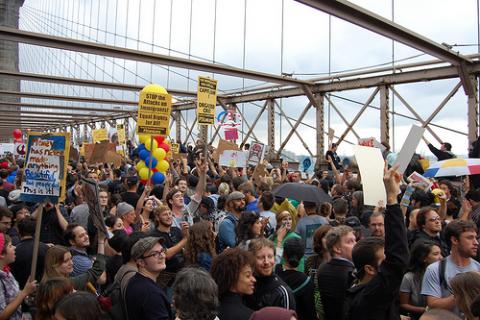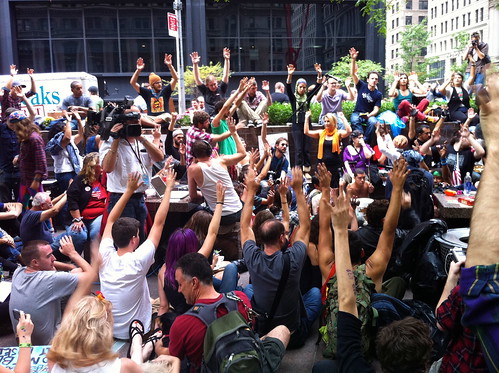Occupy Wall Street grows in size and credibility

What started with fewer than a dozen college students in protesting in Zuccotti Park in Lower Manhattan has ballooned into a movement that has made headlines across the world. Now in its third week, the Occupy Wall Street movement has sparking sister 'Occupy' movements across the United States. By Richard Chambers.
In its boldest statement yet, hundreds of protesters marched on New York's iconic Brooklyn Bridge on Saturday. Through imaginative yet peaceful dissent, the Wall Street protesters have captured an ongoing slot in America's mainstream media. Just as the 15M movement in Spain and activists' across the Middle East, these demonstrators' have given their cause a visibility through the use of social media.
Devoid of police brutality, certain heavy-handed incidents granted Occupy Wall Street a number of publicity coups. Officer Anthony Bologna’s pepper spraying of protesters on 24 September sparked controversy and news of the incident quickly spread around the world. The arrest of over 700 people on Brooklyn Bridge on Saturday similarly caught the imaginations of newsdesks across the world.
Celebrities too, such as actors Alec Baldwin and Susan Sarandon and documentary maker Micheal Moore, have used their public profiles to draw attention to the protest in New York.
Reports on the sequence events that led up to the arrests of over 700 people are conflicting but the arrests themselves, regardless of the circumstances surrounding them, are likely to have a similar galvanising effect on public perception of the protests.
Occupy Boston, Occupy Chicago and other groups inspired by Occupy Wall St are springing up in cities across the United States and spreading north across the border to Canada
The protests share some traits with the Indignados/15M protests in Spain which took place over the summer. A website providing news and resources for the protesters, occupywallst.org, points to the influence which these movements had on this campaign, and also acknowledges the influence of the protests in Tahrir Square in Cairo as well as the Arab Spring more widely.
Adbusters’s post on 13 September calling for a ‘Tahrir moment’ is one of the origins of the movement. The group advocated “one simple demand in a plurality of voices”, that demand they describe as “Democracy not Corporatocracy”. This aim - to remove corporate influence from government - was to be achieved through weeks and months of unrelenting public pressure.
While Occupy Wall Street is unlikely to go so far as, or even seek to emulate, the Arab Spring, it must now decide what its overarching objective is. The diverse backgrounds of the protesters is easy to see from reports and YouTube videos from New York.
Citizens of every persuasion - students, workers, and the unemployed - are coming to protest 'corporate greed', the execution of Troy Davis and other perceived wrongs in the United States. The unifying goal, however, appears to be to seek justice for the perceived crimes that led to the global economic crisis and for the US Government to break its ties with Wall Street.
The acampadas of Spain began with a vast range of goals. The Spanish movement unified, however, and drew up a list of demands (read here). Harmonising their objectives gave the Spanish movement an added purpose.
The next step for Occupy Wall Street and their offshoots across the United States is to present a similarly plausible argument for change. Undoubtedly, though, the support of trade unions is likely to give the movement a boost.

Advice on what the group should ask for has been offered from various quarters. Without a unified goal Occupy Wall Street may amount to nothing in the long term.
That similar protests have never caught on in Ireland is notable. In November 2010, between 50,000 and 100,000 people marched against the final budget of the Fianna Fáil/Greens coalition. Since then, there have been fractured protests by groups opposed to job losses, public sector cuts and education fees but nothing on the scale of what has been seen in New York.
There is an atmosphere of relative apathy towards mass mobilisation in Ireland and the lack of media coverage of the events in New York is unlikely to encourage any similar movements here.
While crowds of thousands of people from a variety of backgrounds and creeds come together in the US, Greece, Spain and even in our nearest neighbour, there has not been a similar outpouring of protest at austerity measures in this country.
With the budget looming and a new wave of spending cuts expected, the atmosphere might soon be rife for a similar outpouring of frustration in Ireland.
{jathumbnailoff}
Image top: bogieharmond.
Image middle: neotint.
